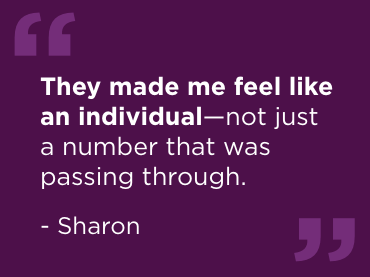The Challenge
Sharon, a 58-year-old librarian from Virginia, makes her livelihood working with words and information. In November 2007 she had a routine eye exam and her vision was fine. Just two months later, she began to have trouble reading small print.
Sharon went back to her ophthalmologist, who sent her to a retinal specialist. The retinal specialist sent her to a neuro-ophthalmologist, who ran a series of tests and determined that Sharon had a craniopharyngioma—a benign brain tumor—that was pressing on her optic nerve.
It was crucial for Sharon to be able to see and read. To lose her vision would mean to lose what she held dear.
"Everyone was so concerned about me and they made me feel like an individual- not just a number that was passing through." — Sharon
The neuro-ophthalmologist recommended a neurosurgeon near Sharon's home.
"I went there and the picture he painted was just awful of how he wanted to do the surgery," Sharon says. "I was in shock. I didn't want this procedure that was very invasive."
Schedule an Appointment or Ask a Question
The Path to UPMC
After hearing about what a traditional craniotomy would involve, Sharon made two appointments to explore her options: one at UPMC in Pittsburgh and another at a medical center about an hour away from her Virginia home. Doctors at UPMC evaluated her case, and said she would be a good candidate for minimally invasive endoscopic endonasal surgery to remove her tumor.
She decided to have surgery at UPMC and cancelled her appointment at the other center.
"I was very impressed by the kindness of the staff at the hospital," Sharon says. "Everyone was so concerned about me and they made me feel like an individual—not just a number that was passing through."
Sharon was also impressed by how the staff spoke of the surgeons. That convinced her she was in the right place.
The Solution
Sharon was referred to a colleague at the UPMC Vision Institute, and was told she would need surgery within a week to preserve her vision.
Craniopharyngiomas typically develop during childhood. For Sharon, the technology would not yet have been available if the tumor had been discovered when she was a child.
The surgeon told her, "You're very lucky. This technology is perfect for the kind of tumor you have. We can help you."
Surgery was immediately scheduled, and the team of neurosurgeons, ophthalmologists, and otolaryngologist-head and neck surgeons removed the tumor using the Endoscopic Endonasal Approach.
The Results
Once the tumor was removed, Sharon's vision returned to normal. Just two weeks after surgery, she was back at work part time. One month after the procedure, Sharon was back to her full-time schedule—and back to the life she was leading before her diagnosis.
Our patient stories profile a number of patients who have had minimally invasive brain surgery at UPMC. Although everyone's care experience is unique, we hope that sharing these stories will help other prospective patients and their families better understand these procedures and their potential benefits.
Sharon's treatment and results may not be representative of all similar cases.

















